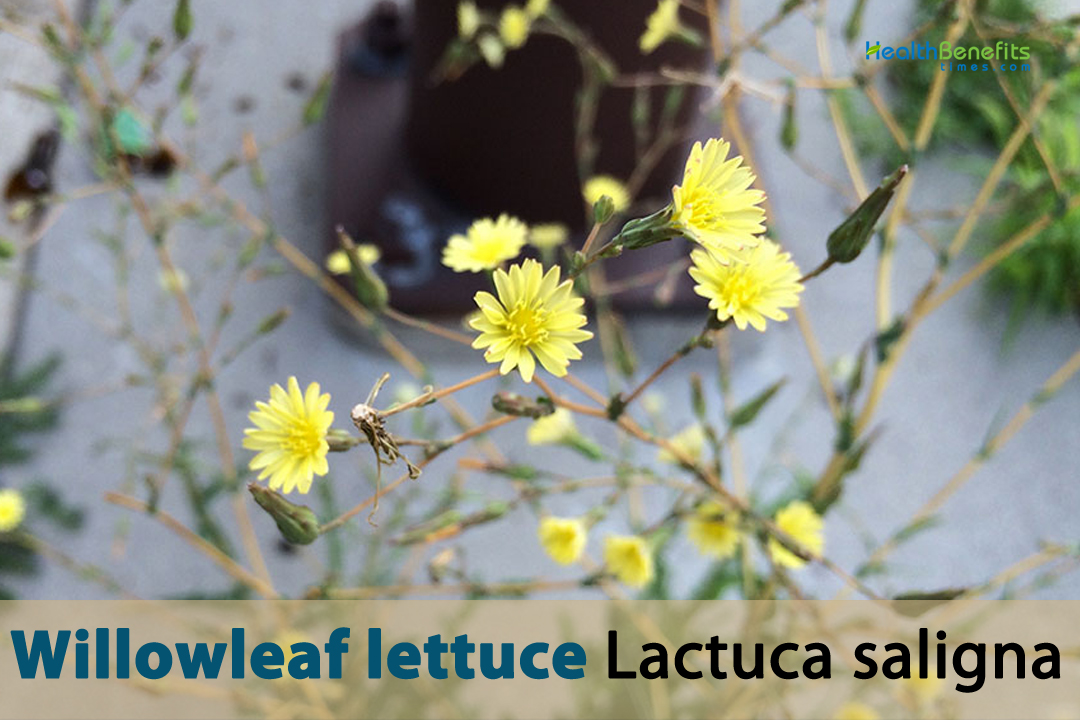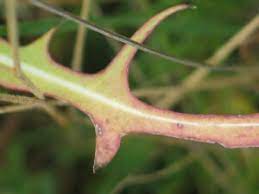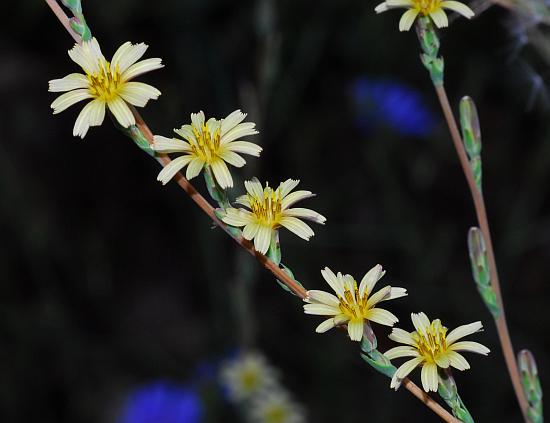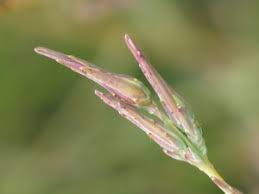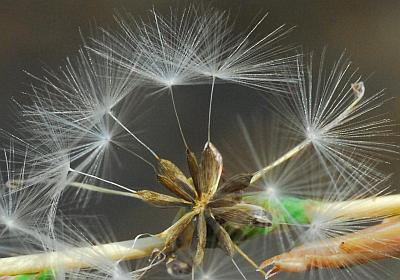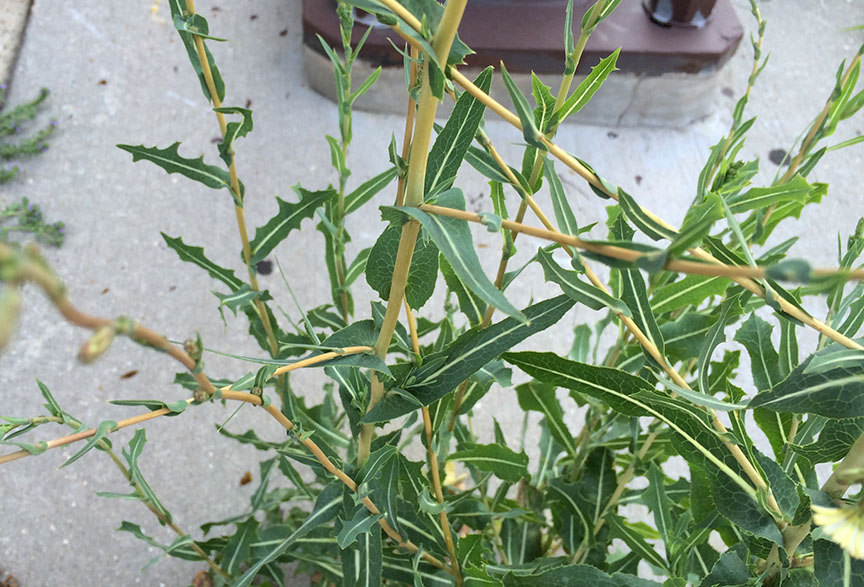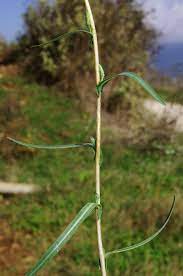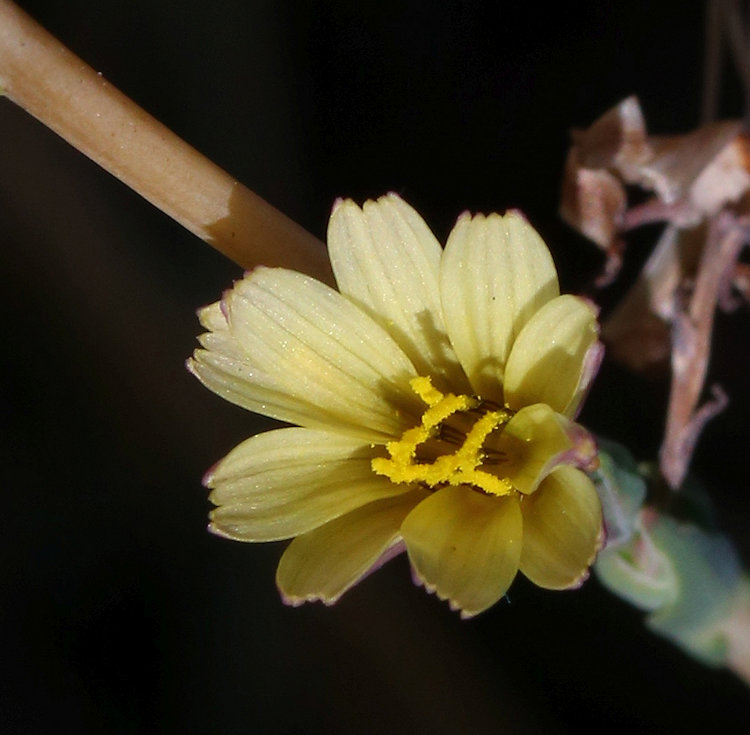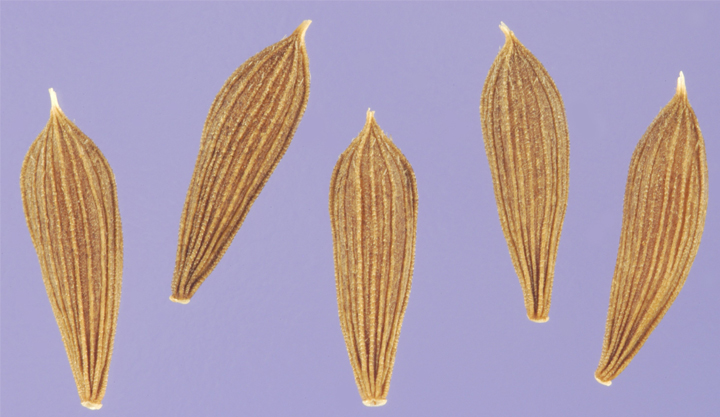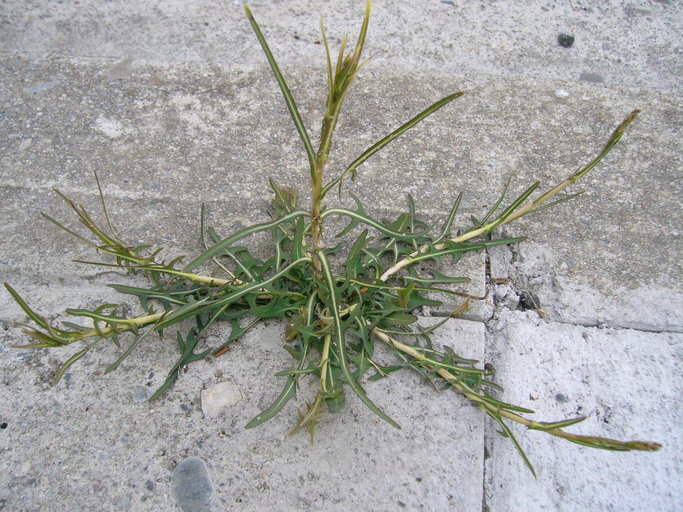| Willowleaf lettuce Quick Facts | |
|---|---|
| Name: | Willowleaf lettuce |
| Scientific Name: | Lactuca saligna |
| Origin | Parts of Europe and Western Asia |
| Colors | Brown or tan in color when mature |
| Shapes | Spiny-ribbed achene (or cypsela) almost 1 cm (1⁄2 in) long with a long white pappus |
| Taste | Mild and slightly bitter taste, with a hint of nuttiness |
| Major nutrients | • Dietary Fiber • Vitamin A • Vitamin K • Vitamin C • Vitamin B9 (Folate) • Potassium • Calcium • Iron • Antioxidants • Water |
| Health benefits | Heart Health, Eye Health, Bone Health, Hydration, Weight Management, Blood Sugar Regulation, Skin Health, Immune Support, Stress Reduction, Detoxification, Anti-Aging Properties |
| Name | Willow leaf lettuce |
|---|---|
| Scientific Name | Lactuca saligna |
| Native | Parts of Europe and Western Asia, but it has naturalized in various regions around the world including much of North America |
| Common Names | Willow leaf lettuce, Willow herb lettuce, Willow-leafed wild lettuce, Persian lettuce, Egyptian lettuce, Willow-leaved chicory, Willow-leaved lettuce, Slender-leaved lettuce, Slenderleaf lettuce, Wild lettuce, Narrow-leaved lettuce, Narrowleaf lettuce |
| Name in Other Languages | Albanian: Marule shelgore, marule me gjethe shelgu Arabic: Khas waraq al-safsaaf (خس ورق الصفصاف), Udhaidh, khas safsafy (خَسّ صَفْصافي), libayn alshaykh (لِبَّيْـن الشَّيْخ), murayr (مُرَّيْر), bbayn alshshaykh (لِبَّيْـن الشَّيْخ), murrayr (مُرَّيْر) Assamese: Wilolof Lettuce (উইলোলেফ লেটুস) Bengali: U’ilolip pata (উইলোলিফ পাতা), U’ilōlipha lēṭusa (উইলোলিফ লেটুস), Selad Pata (সেলাড পাতা) Bulgarian: Vărbova listna salata (Върбова листна салата), Solenolyubiva salata (Соленолюбива салата), tesnolistna salata (теснолистна салата) Chinese: Liǔyè shēngcài (柳叶生菜) Croatian: Salata od vrbovog lišća, vrbolika salata Czech: Vrbový listový salát, Locika vrbová, locika vrbovitá Danish: Pilbladssalat, Dværgsalat Dutch: Wilgenbladsla, Wilgsla English: Willowleaf Lettuce, Least Lettuce, Wild Lettuce, Willow Lettuce, Willow-leaf Lettuce, Willow-leaved Lettuce, Heart lettuce, Narrow-leaf lettuce, Chinese lettuce, wild lettuce Estonian: Paju lehtsalat Filipino: Willowleaf lettuce Finnish: Pajunlehtisalaatti, Pajunsalat, Pajunsalaatti French: Laitue sauvage, Laitue Feuille de Saule, Laitue à feuilles de Saule, laitue saulière German: Weidenblättriger Lattich, Weidenblattsalat, Weiden-Lattich Greek: Fýllo itiás maroúli (Φύλλο ιτιάς μαρούλι), Marouli me fýlla itiás (Μαρούλι με φύλλα ιτιάς), Maroulófillos (Μαρουλόφυλλος), Laktouke e iteofylle (Λακτούκη η ιτεόφυλλη), makrófyllo agriomároulo (μακρόφιλλο αγριομάρουλο) Gujarati: Vilolīph lēṭyūs (વિલોલીફ લેટ્યૂસ), Salad Patra (સલાડ પત્તા) Hebrew: Chasa aleh aravah (חסה עלה ערבה), Khaseh aleh aravah (חסה עלה ערבה), chassah ratemit Hindi: Viloli patti letas (विलोली पत्ती लेटस), Salad Pattiyan (सलाद पत्तियां), Viloli Lettuce (विलोलीफ़ लेटिस) Hungarian: Fűzlevelű saláta, szálas saláta, szálaslevelű saláta, Icelandic: Víðirlauf blómlaukur, Videistblöð sallat Indonesian: Selada daun willow Italian: Lattuga saligna, Lattuga a foglia di salice, Lattuga salcigna Japanese: Yanagi no ha retasu (ヤナギの葉レタス), Yanagirīfuretasu (ヤナギリーフレタス) Kannada: Vil’ōv leṭyūs (ವಿಲೋವ್ ಲೆಟ್ಯೂಸ್), Soppu Soppu (ಸೊಪ್ಪು ಸೊಪ್ಪು) Korean: Beodeulip Sangchu (버들잎 상추) Lithuanian: Vėjos lapinė salota Malay: Selada daun willow Malayalam: Villōv leṟṟūs (വില്ലോവ് ലെറ്റൂസ്), Salad Ila (സലാഡ് ഇല) Marathi: Vilolīph lēṭas (विलोलीफ लेटस), Salad Pane (सलाद पाने) Nepali: U’ilolif leṭs (उइलोलिफ लेट्स) Norwegian: Pileblad-salat Odia: Wilolof Lettuce (ୱିଲୋଲୀଫ୍ ଲେଟସ୍) Persian: Kahu-ye barg-e Willow (کاهوی برگ ویلو) Polish: Sałata wierzbowolistna, Sałata solna Portuguese: Alface-selvagem, Alface de folha de salgueiro, Alface Folha de Salgueiro Punjabi: Vilolef laits (ਵਿਲੋਲੇਫ ਲੈਟਸ), Salad Pattiyan (ਸਲਾਦ ਪੱਤੀਆਂ) Romanian: Salată cu frunze de salcie, Leptuch’ salichin’ (Лэптучь саличинь), lăptuci Russian: Ivovyy latuk (Латук ивовый), List’ya Ivovoy salat (Листья Ивовой салат), latuk solonchakovyy (латук солончаковый) Serbian: Salata od vrbovog lišća, Bodaljac (бодаљац), Šilja, Šiljak, vrbolisna lochika (врболисна лочика), uskolisna salata (усколисна салата) Sinhala: Wilova letus (විලොව් ලෙටූස්) Slovak: Locika vŕbolistý, šalát vŕbolistý Slovenian: Vrbov listnati solat, vrbovolistna ločika Spanish: Lechuga de sauce, Lechuga Hoja de Sauce, escarolilla, forrajas, lechoguinos, lechuga de asno, lechuguetas Swahili: Letusi ya majani ya Willow Swedish: Pilbladssallad, Videbladssallat, Videsallat Tamil: Vil’lōv leṭs (வில்லோவ் லெட்ஸ்), Keerai Kodi (கீரைக் கொடி) Telugu: Vil’ōv leṭs (విలోవ్ లెట్స్), Koora Gayala Aakulu (కూరగాయల ఆకులు) Thai: Phak kād bāi ma-leng wan (ผักกาดใบแมลงวัน), Phak kaŋ khēn̂g h̄rụ̄x phak se lādā (ผักกางเขนหรือผักเซลาดา) Turkish: Söğüt yapraklı marul, Papatya yapraklı marul, deli marul Ukrainian: Salat verbolystyy (Салат верболистий), Verbovyi listkovyi salat (Вербовий листковий салат), latuk solonchakovyy (латук солончаковий) Urdu: Willow leaf patta (ویلو لیف پتہ), Salad Patiyan (سلاد پتیاں) Vietnamese: Rau diếp cây liễu Welsh: Gwylaeth Eiddil, Gwylaeth Leiaf, Gwylaeth Lleiaf, Letus Bach, Letusen Fach |
| Plant Growth Habit | Herbaceous perennial plant |
| Growing Climates | Fallow fields, vineyards, grasslands, meadows, open woodlands, beaches, cliffs, ditches, riverbanks, roadsides, seaside, wasteland, gardens and degraded pastures |
| Soil | Prefers well-drained soil with a slightly acidic to neutral pH |
| Plant Size | About 30 to 60 centimeters (12 to 24 inches) tall and approximately 15 to 30 centimeters (6 to 12 inches) wide |
| Root | Initially develops a primary taproot, which is the first root to emerge from the seed |
| Stem | Spindly, mainly erect stem has bristles on its lower portion. The stems are usually purple or red in color and are also slightly hairy |
| Bark | Doesn’t have a traditional bark like trees or shrubs |
| Leaf | Leaves are long and slender, and can grow up to 30 cm in length. The leaves are alternate and deeply lobed, with a smooth or slightly hairy texture. |
| Flowering season | May to June |
| Flower | Flower head is up to about 4 cm (1+1⁄2 in) wide when open, with rectangular pale yellow ray florets with toothed tips. There are no disc florets |
| Fruit Shape & Size | Spiny-ribbed achene (or cypsela) almost 1 cm (1⁄2 in) long with a long white pappus. |
| Fruit Color | Brown or tan in color when mature |
| Seed | Relatively small, typically measuring only a few millimeters in length |
| Flavor/Aroma | Clean and fresh, with a hint of greenness |
| Taste | Mild and slightly bitter taste, with a hint of nuttiness |
| Plant Parts Used | Sap/Latex, Seeds, Leaves |
| Propagation | By Seed, Self-Seeding, Stem Cuttings, division, Self-Seeding, Transplanting |
| Lifespan | One or two years |
| Season | July to September |
| Major Nutrition |
|
| Available Forms |
|
| Health benefits |
|
Plant Description
Willow leaf lettuce is an herbaceous annual or perennial plant that normally grows about 30 to 60 centimeters (12 to 24 inches) tall and approximately 15 to 30 centimeters (6 to 12 inches) wide. The plant is found growing in dry, open and gravelly places, fallow fields, vineyards, grasslands, meadows, open woodlands, beaches, cliffs, ditches, riverbanks, roadsides, seaside, wasteland, gardens, cultivation, and degraded pastures, stream banks, bottomland forest openings, margins of glades, disturbed portions of bottomland prairies, levees, gardens and railroads. The plant prefers well-drained soil with a slightly acidic to neutral pH. It requires regular moisture but should not be waterlogged.
The leaves and the milky sap of the plant are traditionally used to relieve pain, and it is also used in some remedies for asthma, insomnia and anxiety. In addition to its medicinal uses, it is also an important plant for wildlife. The flowers provide a valuable source of nectar for bees and other pollinators, while the seeds are eaten by birds and small mammals. In conclusion, it may not be as well-known as its domesticated relative, but it is an interesting and important plant in its own right. Its sedative properties and importance to wildlife make it a valuable addition to any garden or natural area.
Appropriate growing environment for Willow leaf lettuce
Willow leaf lettuce is a type of leafy green vegetable. To provide an appropriate growing environment for willow leaf lettuce, you should consider the following factors:
- Climate: Willow leaf lettuce prefers cooler temperatures and is best grown in spring or fall. It can tolerate mild frost but does poorly in hot weather.
- Sunlight: Provide full sun to partial shade. It’s best to give it around 6 hours of sunlight per day, but it can tolerate some shade during the hottest part of the day in warm climates.
- Soil: Use well-draining soil rich in organic matter. A slightly acidic to neutral pH (around 6.0 to 7.0) is ideal.
- Watering: Keep the soil consistently moist but not waterlogged. Ensure proper drainage to prevent root rot.
- Spacing: Space the plants about 6-8 inches apart to allow for proper air circulation and growth.
- Fertilization: Willow leaf lettuce benefits from regular applications of a balanced, soluble fertilizer. Follow the instructions on the fertilizer package for the correct dosage and frequency.
- Mulching: Mulch the soil around the lettuce plants to help retain moisture and regulate soil temperature.
- Companion Planting: Planting willow leaf lettuce near other cool-season crops like carrots, radishes, or spinach can provide mutual benefits by sharing space and deterring pests.
- Pest and Disease Management: Bugs that like greens, like aphids, slugs, and snails, should be watched out for. If you need to, use the right ways to get rid of pests. To avoid fungus diseases, don’t water from above.
- Harvesting: Harvest the outer leaves when they reach a desirable size, typically 4-6 inches in length. This allows the inner leaves to continue growing for a longer harvest period.
- Successive Planting: To ensure a continuous supply of fresh leaves, consider planting new seeds every few weeks during the growing season.
- Protection: In extremely hot weather, provide shade or use row covers to protect the lettuce from excessive sun and heat.
Roots
Willow leaf lettuce initially develops a primary taproot, which is the first root to emerge from the seed. The taproot is typically thicker and longer than the lateral roots. It grows directly downward into the soil. As the Willow leaf lettuce plant continues to grow, it produces lateral roots that branch off from the primary taproot. These lateral roots extend horizontally and diagonally away from the primary taproot. Some plants, particularly legumes, form root nodules in association with nitrogen-fixing bacteria (e.g., rhizobia). These nodules can convert atmospheric nitrogen into a form that the plant can use for growth. Willow leaf lettuce does not typically form root nodules, as it is not a legume. The lateral roots are responsible for absorbing water and essential nutrients from the soil. They have root hairs on their surfaces, which increase the surface area for absorption.
Stem
Willow leaf lettuce has a typical herbaceous stem, which means that it is non-woody and remains soft and green throughout its life cycle. The stem is generally slender and upright, growing vertically above the ground. Willow leaf lettuce typically exhibits a rosette growth habit, where the leaves form a circular or rosette-like arrangement at the base of the stem. The stem elongates as the plant matures, allowing the leaves to be positioned above the ground. The stem is characterized by distinct internodes, which are the regions between nodes (points on the stem where leaves, branches, or flowers emerge). As the plant grows, the internodes elongate, causing the stem to lengthen. Stems, like the rest of the plant, remain tender and edible, especially in the early stages of growth. However, as the plant bolts and matures, the stem can become tougher and less palatable. Therefore, in culinary applications, it’s common to harvest before it bolts to ensure tenderness.
Bark
Bark of a plant typically refers to the outer protective layer of tissue on the stems and branches of woody plants. However, when it comes to lettuce, like the Willow leaf lettuce, it doesn’t have a traditional bark like trees or shrubs. Lettuce is an herbaceous plant, which means it doesn’t have a woody stem or bark in the same way that trees or shrubs do.
Leaves
Willow leaf lettuce gets its name from the shape of its leaves, which are elongated and somewhat resemble the leaves of a willow tree. Leaves are lance-shaped or linear and have pointed tips. They can vary in size but are generally longer and narrower than the leaves of other lettuce varieties. The leaves have a relatively smooth texture. They are not as deeply lobed or frilled as some other lettuce varieties, such as the curly-leafed varieties. The color is typically a medium to dark green. However, leaf color can vary somewhat depending on factors like growing conditions and maturity. Younger leaves may be lighter green, while older leaves may darken. Like most lettuce varieties, its leaves have prominent veins. These veins are often lighter in color than the leaf tissue and can give the leaves a slightly textured appearance.
The leaves are arranged in a rosette form. This means that they grow in a circular pattern close to the ground, with the younger, inner leaves at the center and the older, outer leaves radiating outward. The edges of leaves are typically smooth and not serrated or toothed. This contributes to the lance-shaped appearance of the leaves. The size can vary, but they are generally smaller and more slender compared to other lettuce varieties. The length of the leaves can range from a few inches to around a foot or more, depending on factors like growing conditions and how they are cultivated. Each leaf is attached to the central stem of the plant by a petiole (leaf stalk). The petiole connects the leaf to the main stem, allowing the leaf to grow from the center of the rosette. Leaves have a mild and slightly sweet flavor, making them a popular choice for salads and sandwiches.
Flower
Willow leaf lettuce produces small, daisy-like flowers that are arranged in an inflorescence known as a capitulum or a flower head. The capitulum is composed of numerous individual flowers clustered closely together. Each “flower” within the capitulum is not a single flower but a composite flower, which consists of two types of florets: ray florets and disc florets. The outermost “petals” of the daisy-like flower head are actually specialized flowers called ray florets. These are typically ligulate, meaning they have a strap-like appearance and don’t contain reproductive structures. These ray florets are usually a bright yellow color, which creates the appearance of yellow petals.
Center of the flower head contains disc florets. These are the true reproductive flowers and have a tubular shape. They are typically a darker yellow color. Each disc floret consists of reproductive parts, including stamens (male parts) and a pistil (female part). The pistil contains the ovary, style, and stigma, where pollination and fertilization occur. Flowers are typically small, and the capitulum is held on a long stem. The arrangement of the florets in the capitulum creates a visually striking appearance, with the ray florets forming an outer “ring” of “petals” around the central disc florets. Willow leaf lettuce is known for producing these flowers in late spring to early summer, depending on the climate and growing conditions. Like many plants in the Asteraceae family, Willow leaf lettuce flowers are often pollinated by insects, particularly bees and butterflies, which visit the flowers to collect nectar and inadvertently transfer pollen between florets.
Fruits
Willow leaf lettuce achenes are small, dry, and seed-like structures. They are typically elongated and somewhat cylindrical in shape. Each achene is approximately 3-5 millimeters in length. Inside each achene, you will find a single seed. Seed is relatively small, and it is the product of fertilization of the flower’s ovule. One distinctive feature of Willow leaf lettuce achenes is the presence of a pappus. The pappus is a tuft of fine, hair-like structures that are attached to the top of the achene. These hairs can be quite feathery and serve as an adaptation for wind dispersal. When the plant is ready to disperse its seeds, the pappus allows the achene to be carried by the wind over distances. Willow leaf lettuce achenes are typically brown or tan in color when mature.
Seeds
Willow leaf lettuce seeds are relatively small, typically measuring only a few millimeters in length. They are elongated and somewhat cylindrical in shape. The exact size and shape of the seeds can vary somewhat depending on factors such as growing conditions and genetic variation. Mature seeds are usually brown or tan in color. The coloration can help distinguish them from other parts of the plant, such as the green leaves and stems. Each seed is encased in a protective seed coat or seed coat membrane. The seed coat serves to protect the seed from external factors, such as moisture and pathogens that could potentially harm the seed.
Inside the seed coat is the embryo, which is the young plant in a dormant state. The embryo consists of the first leaves (cotyledons), the shoot tip (plumule), and the root tip (radicle). When conditions are favorable, the embryo will undergo germination, where it starts to grow into a new Willow leaf lettuce plant.
Health benefits of Willow leaf lettuce
Willow leaf lettuce is a leafy green vegetable that offers several potential health benefits:
1. Nutrient-Rich
Willow leaf lettuce is a good source of essential nutrients, including vitamins and minerals such as vitamin A, vitamin C, vitamin K, folate, and iron. These nutrients are important for overall health and wellbeing.
2. Low in Calories
This lettuce variety is low in calories, making it a great choice for those looking to manage their weight. It provides bulk to meals without adding excess calories.
3. Antioxidant Properties
Willow leaf lettuce contains antioxidants, including beta-carotene and vitamin C, which help protect the body’s cells from damage caused by free radicals. Antioxidants play a role in reducing the risk of chronic diseases.
4. Rich in Fiber
Like other leafy greens, it is a good source of dietary fiber. Fiber promotes healthy digestion, helps maintain regular bowel movements, and may contribute to a feeling of fullness, aiding in weight management.
5. Heart Health
The fiber content can help lower cholesterol levels and support heart health by reducing the risk of heart disease. Additionally, the presence of potassium in leafy greens can help regulate blood pressure.
6. Eye Health
The vitamin A content in willow leaf lettuce is essential for maintaining good vision and eye health. It supports the health of the retina and can help prevent age-related macular degeneration.
7. Bone Health
Willow leaf lettuce contains vitamin K, which is crucial for bone health. It helps in calcium absorption and bone mineralization, reducing the risk of osteoporosis.
8. Anti-Inflammatory Properties
Some studies suggest that certain compounds found in leafy greens, including lettuce, may have anti-inflammatory effects, which can benefit overall health and potentially reduce the risk of chronic diseases associated with inflammation.
9. Hydration
Lettuce, including willow leaf lettuce, has a high water content, which can help with hydration. Proper hydration is essential for various bodily functions and overall health.
10. Weight Management
Due to its low calorie and high fiber content, it can be a valuable addition to a weight management or weight loss diet. It can help you feel full and satisfied while consuming fewer calories.
11. Blood Sugar Regulation
Willow leaf lettuce contains compounds that may help regulate blood sugar levels. Its low glycemic index and fiber content can contribute to more stable blood glucose levels, making it a suitable choice for individuals with diabetes or those looking to prevent blood sugar spikes.
12. Digestive Health
The fiber in Willow leaf lettuce aids in promoting a healthy digestive system. It helps prevent constipation by adding bulk to the stool and supports the growth of beneficial gut bacteria, which are important for digestive health.
13. Anti-Cancer Potential
While more research is needed, some studies suggest that certain phytochemicals found in leafy greens, including Willow leaf lettuce, may have anti-cancer properties. These compounds can help protect cells from DNA damage and inhibit the growth of cancer cells.
14. Skin Health
Vitamin A content in Willow leaf lettuce plays a role in maintaining healthy skin. It supports the growth and repair of skin tissues and can help prevent skin issues such as acne and premature aging.
15. Immune Support
Vitamin C, present in Willow leaf lettuce, is known for its immune-boosting properties. It helps the body produce white blood cells and antibodies, strengthening the immune system’s ability to fight infections.
16. Stress Reduction
Some nutrients in Willow leaf lettuce, such as magnesium and folate, have been associated with stress reduction and improved mood. Folate, in particular, is involved in the production of neurotransmitters like serotonin, which play a role in mood regulation.
17. Detoxification
The chlorophyll content in leafy greens, including Willow leaf lettuce, may support the body’s natural detoxification processes. Chlorophyll can help eliminate toxins and heavy metals from the body.
18. Anti-Aging Properties
Antioxidants in Willow leaf lettuce, including vitamin C and beta-carotene, help combat oxidative stress and free radical damage. This can contribute to a more youthful appearance and may slow the aging process.
Culinary uses of Willow leaf lettuce
Willow leaf lettuce can be used in various culinary applications, much like other leafy greens. Here are some common culinary uses:
- Salads: It can be used as a base for salads, either on its own or mixed with other salad greens like romaine lettuce, spinach, arugula, or kale. Its mild, slightly bitter flavor adds freshness and texture to salads.
- Sandwiches and Wraps: Use Willow leaf lettuce leaves as a crisp and healthy alternative to traditional iceberg lettuce in sandwiches, burgers, and wraps. It provides a satisfying crunch and a burst of green color.
- Garnish: Spruce up your dishes with Willow leaf lettuce as a garnish. It can add a decorative touch to various appetizers, main courses, and even soups. Use whole leaves or finely chopped pieces as a finishing touch.
- Smoothies: Some people include leafy greens like Willow leaf lettuce into their smoothies for an added nutritional boost. It blends well with fruits and other vegetables, contributing a mild earthy flavor.
- Stir-Fries: For a quick and healthy addition to stir-fried dishes, consider adding Willow leaf lettuce towards the end of cooking. Its tender leaves will wilt slightly, providing a fresh, green element to your stir-fry.
- Pasta Dishes: Toss torn or chopped Willow leaf lettuce leaves into pasta dishes just before serving to add a vibrant green color and a subtle, refreshing taste.
- Soups: While Willow leaf lettuce is not typically used in soups, you can experiment with adding it to soups that require a mild, leafy addition. Be sure to add it towards the end of cooking to retain its crispness.
- Green Smoothie Bowls: Create nutritious and visually appealing green smoothie bowls by blending Willow leaf lettuce with fruits, yogurt, and toppings like granola, nuts, and berries.
- Spring Rolls: Leaves are often used in Vietnamese spring rolls. They provide a refreshing and crunchy element when wrapped around a combination of vegetables, herbs, and protein.
- Bowl Meals: Incorporate Willow leaf lettuce into grain bowls, Buddha bowls, or poke bowls. It adds a fresh, leafy component to these customizable, balanced meals.
- Healthy Wraps: Instead of traditional tortillas, use Willow leaf lettuce leaves as wrappers for fillings like grilled chicken, tofu, quinoa, or hummus for a low-carb and gluten-free alternative.
- Sushi Rolls: Some sushi rolls, such as vegetarian or vegetable rolls, may include Willow leaf lettuce as one of the fillings, adding a pleasant crunch and a hint of green to the rolls.
- Tacos: Use Willow leaf lettuce leaves as a taco shell alternative for a lighter, gluten-free, and low-carb option. Fill them with your favorite taco ingredients like seasoned ground meat, beans, cheese, salsa, and avocado.
- Sushi Salad: Create a deconstructed sushi salad by tossing torn leaves with sushi rice, diced raw fish or seafood, avocado, cucumber, and soy sauce-based dressing. It’s a refreshing take on traditional sushi.
- Spring Salad Rolls: Make fresh and healthy spring salad rolls by wrapping leaves around a combination of julienned vegetables, rice noodles, and protein. Dip them in a tasty peanut or hoisin sauce.
- Herb Blends: It can be added to herb blends like pesto or chimichurri, enhancing their flavor and providing a unique twist on classic recipes.
- Smoothie Booster: If you’re making a green smoothie, blend a handful of leaves along with fruits and other greens. It can contribute to the smoothie’s nutritional profile without significantly altering the taste.
- Stuffed Willow leaf Lettuce: Create stuffed Willow leaf lettuce leaves by filling them with a variety of ingredients such as quinoa, roasted vegetables, crumbled cheese, nuts, and a drizzle of vinaigrette. Serve them as a light appetizer or side dish.
- Sautéed Greens: Quickly sauté lettuce in olive oil with garlic and seasonings for a warm wilted green side dish. It’s a great way to use up excess lettuce and enjoy a different texture.
- Green Juices: If you have a juicer, you can extract the juice from Willow leaf lettuce and combine it with other fruits and vegetables for a nutritious green juice.
- Egg Wraps: Create a healthy breakfast or brunch by using Willow leaf lettuce leaves as a wrap for scrambled eggs, sautéed vegetables, and a sprinkle of cheese.
- Lettuce Cups: Similar to using iceberg lettuce, use Willow leaf lettuce leaves as cups to hold various fillings like chicken salad, tuna salad, or diced fresh fruit for a fun and refreshing appetizer or snack.
- Homemade Pesto: Incorporate Willow leaf lettuce into homemade pesto sauce for a milder and slightly sweet variation of the classic basil pesto.
- Rice Paper Rolls: Combine Willow leaf lettuce with other herbs and vegetables to make rice paper rolls. These fresh and light Vietnamese rolls are perfect for dipping in peanut sauce or fish sauce.
- Sautéed with Garlic and Lemon: Quickly sauté Willow leaf lettuce with garlic, lemon juice, and a dash of red pepper flakes for a zesty and nutritious side dish.
Different uses of Willow leaf lettuce
Willow leaf lettuce is a versatile plant that has been used in various ways beyond culinary applications. Here are different uses of Willow leaf lettuce:
- Wildlife Habitat: As a native plant in some regions, it can serve as a valuable food source for wildlife, including various bird species and small mammals. It contributes to the biodiversity of local ecosystems.
- Companion Plant: In gardening, some people plant Willow leaf lettuce near other crops as a companion plant. It is believed to deter certain pests, like aphids, from the neighboring plants due to its bitter taste.
- Botanical Interest: It can be grown for its ornamental value. Its tall, spiky flower stalks and bright yellow flowers can be a unique addition to garden landscapes.
- Educational Purposes: It is sometimes used in educational settings to teach students about native plant species, foraging, and the ecological importance of wild plants.
- Conservation: In some areas, efforts are made to conserve native plant species like Willow leaf lettuce to protect biodiversity and preserve the natural habitat.
- Dye Production: Historically, the sap has been used as a natural dye to produce various shades of yellow.
- Botanical Research: Willow leaf lettuce is of interest to botanists and researchers studying plant genetics, evolution, and ecology.
- Erosion Control: Willow leaf lettuce, with its deep root system, can help stabilize soil on slopes and prevent erosion. Its extensive roots can bind the soil together, making it a useful plant for erosion control in environmentally sensitive areas.
- Aesthetic Landscaping: Due to its tall flower stalks and bright yellow flowers, Willow leaf lettuce can be grown for ornamental purposes in gardens and landscaping. It adds a unique and visually appealing element to flower beds and naturalized areas.
- Natural Pest Control: While Willow leaf lettuce can deter some pests as a companion plant, it can also attract beneficial insects like ladybugs and lacewings, which prey on garden pests such as aphids and mites. This can contribute to a more balanced and pest-resistant garden ecosystem.
- Seed Production: Willow leaf lettuce produces seeds that can be collected and saved for future planting. This can be particularly valuable for those interested in native plant conservation or cultivating their own wildflower gardens.
- Habitat Restoration: In ecological restoration projects, native plants like Willow leaf lettuce may be reintroduced to natural areas to help restore native ecosystems and provide food and habitat for local wildlife.
- Educational Tool: Willow leaf lettuce can be used as an educational tool to teach students and the public about native plants, biodiversity, and the importance of preserving natural habitats.
- Traditional Crafts: Some indigenous cultures have historically used the fibers from Willow leaf lettuce stems for making baskets, cordage, and other traditional crafts.
- Food for Livestock: In some regions, Willow leaf lettuce may be used as forage for livestock, particularly in times of scarcity when other vegetation is limited.
- Conservation: Efforts to protect and conserve native plant species like Willow leaf lettuce are important for maintaining biodiversity and preserving the genetic diversity of native flora.
Side effects of Willow leaf lettuce
Willow leaf lettuce is generally considered safe for consumption in moderate amounts, particularly in culinary applications. However, it’s important to be aware of potential side effects and considerations, especially when used for medicinal purposes or if you have specific health conditions. Here are some side effects and considerations associated with Willow leaf lettuce:
- Allergic Reactions: Some individuals may be allergic to certain types of lettuce, including Willow leaf lettuce. Allergic reactions can range from mild symptoms like itching, skin rashes, and sneezing to more severe reactions like difficulty breathing or anaphylaxis in rare cases. If you have known lettuce allergies, it’s best to avoid Willow leaf lettuce.
- Sedative Effect: Willow leaf lettuce has a mild sedative effect, which can be beneficial for some individuals seeking relaxation or relief from mild anxiety. However, excessive consumption may lead to drowsiness or fatigue. It’s important not to consume large quantities before activities that require alertness, such as driving.
- Digestive Upset: Eating excessive amounts of raw lettuce, including Willow leaf lettuce, may sometimes lead to digestive discomfort, such as gas, bloating, or diarrhea, particularly in individuals with sensitive digestive systems.
- Toxic Lookalikes: While Willow leaf lettuce is generally safe to eat, there are other wild plants, such as certain types of wild lettuce that can contain bitter-tasting compounds and latex with potential toxic effects if consumed in large quantities. It’s crucial to correctly identify the plant before consumption.
- Interactions with Medications: If you are taking medications or have underlying medical conditions, consult with a healthcare provider before using Willow leaf lettuce medicinally. Its potential sedative properties may interact with certain medications, such as sedatives or antidepressants.
- Pregnancy and Breastfeeding: Pregnant and breastfeeding individuals should consume Willow leaf lettuce in moderation as part of a balanced diet. While it is generally safe, excessive consumption during pregnancy may not be advisable due to its mild sedative properties.
- Hypersensitivity: Individuals with a history of allergies or sensitivities to plants in the Asteraceae family (such as ragweed, marigolds, and daisies) may be more likely to experience allergic reactions to Willow leaf lettuce.
- Medicinal Use Caution: If considering Willow leaf lettuce for medicinal purposes, always consult with a qualified herbalist or healthcare provider. Self-medicating with herbal remedies, including Willow leaf lettuce, without professional guidance can have unintended consequences.
References:
https://www.itis.gov/servlet/SingleRpt/SingleRpt?search_topic=TSN&search_value=36606#null
https://npgsweb.ars-grin.gov/gringlobal/taxon/taxonomydetail?id=21359
https://www.cabidigitallibrary.org/doi/10.1079/cabicompendium.115096
https://gd.eppo.int/taxon/LACSL
https://en.wikipedia.org/wiki/Lactuca_saligna
https://www.inaturalist.org/taxa/53105-Lactuca-saligna
http://www.theplantlist.org/tpl1.1/record/gcc-6645
https://plants.usda.gov/home/plantProfile?symbol=LASA
https://www.missouriplants.com/Lactuca_saligna_page.html


